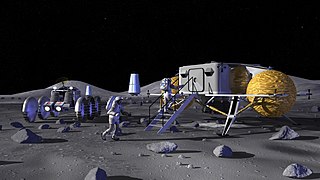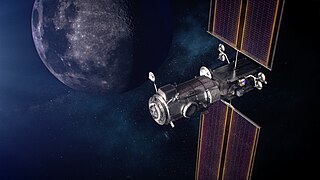
Space exploration is the use of astronomy and space technology to explore outer space. While the exploration of space is currently carried out mainly by astronomers with telescopes, its physical exploration is conducted both by uncrewed robotic space probes and human spaceflight. Space exploration, like its classical form astronomy, is one of the main sources for space science.

The Constellation program was a crewed spaceflight program developed by NASA, the space agency of the United States, from 2005 to 2009. The major goals of the program were "completion of the International Space Station" and a "return to the Moon no later than 2020" with a crewed flight to the planet Mars as the ultimate goal. The program's logo reflected the three stages of the program: the Earth (ISS), the Moon, and finally Mars—while the Mars goal also found expression in the name given to the program's booster rockets: Ares. The technological aims of the program included the regaining of significant astronaut experience beyond low Earth orbit and the development of technologies necessary to enable sustained human presence on other planetary bodies.

The Vision for Space Exploration (VSE) was a plan for space exploration announced on January 14, 2004 by President George W. Bush. It was conceived as a response to the Space Shuttle Columbia disaster, the state of human spaceflight at NASA, and as a way to regain public enthusiasm for space exploration.

Shuttle-derived vehicles (SDV) are space launch vehicles and spacecraft that use components, technology, and infrastructure originally developed for the Space Shuttle program.

The Space Transportation System (STS), also known internally to NASA as the Integrated Program Plan (IPP), was a proposed system of reusable crewed space vehicles envisioned in 1969 to support extended operations beyond the Apollo program. The purpose of the system was two-fold: to reduce the cost of spaceflight by replacing the current method of launching capsules on expendable rockets with reusable spacecraft; and to support ambitious follow-on programs including permanent orbiting space stations around Earth and the Moon, and a human landing mission to Mars.

The Exploration Systems Architecture Study (ESAS) is the official title of a large-scale, system level study released by the National Aeronautics and Space Administration (NASA) in November 2005 of his goal of returning astronauts to the Moon and eventually Mars—known as the Vision for Space Exploration. The Constellation Program was cancelled in 2010 by the Obama Administration and replaced with the Space Launch System, later renamed as the Artemis Program in 2017 under the Trump Administration.

A Mars sample-return (MSR) mission is a proposed mission to collect rock and dust samples on Mars and return them to Earth. Such a mission would allow more extensive analysis than that allowed by onboard sensors.

The Ares V was the planned cargo launch component of the cancelled NASA Constellation program, which was to have replaced the Space Shuttle after its retirement in 2011. Ares V was also planned to carry supplies for a human presence on Mars. Ares V and the smaller Ares I were named after Ares, the Greek god of war.

NASA proposed several concept moonbases for achieving a permanent presence of humans on the Moon since the late 1950s. Research and exploration of the Moon has been a large focus of the organization since the Apollo program. NASA's peak budget was in 1964-1965, when it comprised 4% of all federal spending in service of the Apollo Moon landing project. Though lunar landings ever since the conclusion of the Apollo program in 1972 have ceased, interest in establishing a permanent habitation on the lunar surface or beyond low Earth orbit has remained steady. Recently, renewed interest in lunar landing has led to increased funding and project planning. NASA requested an increase in the 2020 budget of $1.6 billion, in order to make another crewed mission to the Moon under the Artemis program by 2025, followed by a sustained presence on the Moon by 2028. A crew was selected for the planned crewed mission, Artemis II, in April 2023.

The Space Exploration Initiative was a 1989–1993 space public policy initiative of the George H. W. Bush administration.

The National Aeronautics and Space Administration is an independent agency of the U.S. federal government responsible for the civil space program, aeronautics research, and space research. Established in 1958, it succeeded the National Advisory Committee for Aeronautics (NACA) to give the U.S. space development effort a distinctly civilian orientation, emphasizing peaceful applications in space science. It has since led most American space exploration, including Project Mercury, Project Gemini, the 1968–1972 Apollo Moon landing missions, the Skylab space station, and the Space Shuttle. It currently supports the International Space Station and oversees the development of the Orion spacecraft and the Space Launch System for the crewed lunar Artemis program, the Commercial Crew spacecraft, and the planned Lunar Gateway space station.

The space policy of the Barack Obama administration was announced by U.S. President Barack Obama on April 15, 2010, at a major space policy speech at Kennedy Space Center. He committed to increasing NASA funding by $6 billion over five years and completing the design of a new heavy-lift launch vehicle by 2015 and to begin construction thereafter. He also predicted a U.S.-crewed orbital Mars mission by the mid-2030s, preceded by the Asteroid Redirect Mission by 2025. In response to concerns over job losses, Obama promised a $40 million effort to help Space Coast workers affected by the cancellation of the Space Shuttle program and Constellation program.

The space policy of the United States includes both the making of space policy through the legislative process, and the implementation of that policy in the United States' civilian and military space programs through regulatory agencies. The early history of United States space policy is linked to the US–Soviet Space Race of the 1960s, which gave way to the Space Shuttle program. At the moment, the US space policy is aimed at the exploration of the Moon and the subsequent colonization of Mars.

Mars Exploration Program (MEP) is a long-term effort to explore the planet Mars, funded and led by NASA. Formed in 1993, MEP has made use of orbital spacecraft, landers, and Mars rovers to explore the possibilities of life on Mars, as well as the planet's climate and natural resources. The program is managed by NASA's Science Mission Directorate by Doug McCuistion of the Planetary Science Division. As a result of 40% cuts to NASA's budget for fiscal year 2013, the Mars Program Planning Group (MPPG) was formed to help reformulate the MEP, bringing together leaders of NASA's technology, science, human operations, and science missions.

The Asteroid Redirect Mission (ARM), also known as the Asteroid Retrieval and Utilization (ARU) mission and the Asteroid Initiative, was a space mission proposed by NASA in 2013; the mission was later cancelled. The Asteroid Retrieval Robotic Mission (ARRM) spacecraft would rendezvous with a large near-Earth asteroid and use robotic arms with anchoring grippers to retrieve a 4-meter boulder from the asteroid.

Artemis 3 is planned to be the first crewed Moon landing mission of the Artemis program and the first crewed flight of the Starship HLS lander. Artemis 3 is planned to be the second crewed Artemis mission and the first American crewed lunar landing since Apollo 17 in December 1972. In December 2023, the Government Accountability Office reported that the mission is not likely to occur before 2027; as of January 2024, NASA officially expects Artemis 3 to launch no earlier than September 2026.

The Lunar Gateway, or simply Gateway, is a space station which Artemis program participants plan to assemble in an orbit near the Moon. The Gateway is intended to serve as a communication hub, science laboratory, and habitation module for astronauts. It is a multinational collaborative project: participants include NASA, the European Space Agency (ESA), the Japan Aerospace Exploration Agency (JAXA), the Canadian Space Agency (CSA) and the Mohammed Bin Rashid Space Centre (MBRSC). The Gateway is planned to be the first space station beyond low Earth orbit.
The future of space exploration involves both telescopic exploration and the physical exploration of space by robotic spacecraft and human spaceflight.















